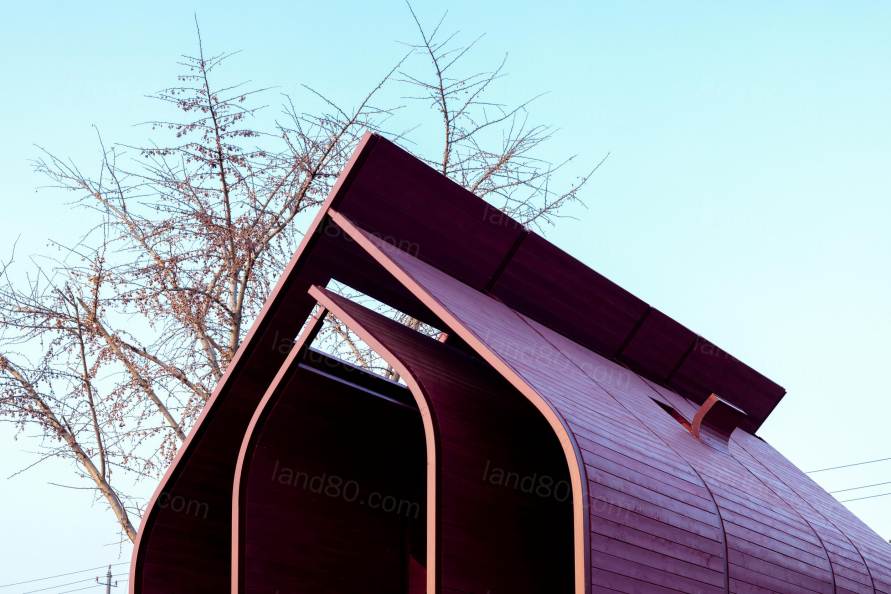本次空间实验是木屋1号的姊妹设计,场地仍然位于江苏镇江江心岛的旅游区的临河
边,作为能够为村民和游客提供休息的场所的社交发生器,我们依然从非功能的角度入手考虑设计。
This spatial experiment is a sister design
of Wooden House No. 1. The site is still located near the river in the tourist
area of Jiangxin Island in Zhenjiang, Jiangsu Province. As a social generator
that can provide resting places for villagers and tourists, we still consider
the design from a non-functional point of view.

▽场地现状 Site status

动态的空间关系学:关系与空间Proxemics: relationship and space
如何用临时性的微型建筑激发场地中的活动,项目的设计研究者们回归的建筑的空间
诉求,从宏观场地环境和微观的人体活动行为进行理论探讨。正如凯文林奇之节点,
在小的尺度上增加人与人的社交可能性,再在宏观的角度上激活社区的活力。
This project is a spatial experiment on
using small-scaled temporary buildings to stimulate the site. The research
comes from original architectural aspirations, theoretically exploring them
from macro and micro perspectives. The building properties change based on
demand, with the material basis determining its properties: from the primitive
hut that realizes the basic needs of human living, to the church that holds the
common faith and provides the earliest formal gathering spaces; the current
living space has to enhance the quality of life of users, and further to
meet their spiritual needs. This requires a new approach in architecture: to
detect macroscopic urban problems and propose systems to correct them by means
of architecture. On a small scale, it raises communication opportunities for
people and further activates the vitality of the community at a macro level.
▽人体尺度之“原始小屋” The primitivism hut of the human dimension


▽内与外的交流 The Communication Between the Inner and Outer Spaces


▽水平与垂直的瞭望窗 The Parallel and Vertical Observation Window

▽冥想,观察,冥想 Meditation, observation, meditation

在《隐秘的维度》一书中,爱德华霍顿用距离来丈量微观尺度上人的亲密关系,进而
用类型学的分类总结出了人类的空间关系学。从近到远,几种社交关系可以被分类
为:亲密(0到18英寸)、私人(18英寸到4英尺)、社交(4到10英尺)、公共
(10英尺以上);交流者之间的社会关系影响着社交距离的生成。换言之,通过设定
人与人之间的社交距离,可以相对应地致使其使用者在空间中的生成特定的感觉及行
为。
In The Hidden Dimension, Edward Horton used
distance to measure human intimacy on a microscopic scale, which topologically
classified the behaviorology. According to the distance, several social
relationships can be classified as: intimate (0 to 18 inches), private (18
inches to 4 feet), social (4 to 10 feet), and public (more than 10 feet); the
social relationship between individuals influences the generation of social
distance and social relationships. In other words, by setting the social
distances between people, it can correspondingly cause its users to generate
specific feelings and behaviors in the space.
▽环境、空间和人的关系 environment space and human

基于以上的研究,“堂”基于人体尺度,用“切片”的概念,设定不同空间指引人和
人的交往模式。从具体的设计而言,“堂”的设计方针先是从人的尺度出发;再结合
空间关系学、人类行为学与人体工学,进一步设定游览者在空间中的具体路径及行
为。故而人在不同的切片尺度中进行多样的社交活动,并与西面河流的自然环境与东
面村落的人文环境相和谐。
Based on previous theoretical
research, Wooden Pavilion #2 is a prototype combining theory and
practice: based on a human scale, each section of the pavilion is used to set
different spaces to guide people and their interaction patterns. In terms of
the specific design process, the formation strategy of Wooden Pavilion #2 begins
from the human scale, and then combines proxemics, behaviorology, and
ergonomics to further set up the specific path and behavior of visitors in the
space. Therefore, people carry out various social activities in the various
sections of the pavilion, while enjoying the harmonious natural environment of
the river in the west, and the humanistic environment of the village in the
east.
▽自然与人造之对话 The communication between the nature and the man-made

▽坚直与柔软 Stiffness versus fluffiness

此前,周边村子中长期缺少宜人实用的公共空间。而此建筑不仅与村落传统建筑形式
产生对话,也为村民服务。闲暇之余,村民们在此进行公共性社交,享受体验建筑空
间与周边自然环境之间融洽和谐的关系。空间与人社交关系的理论性,在村民们的实
际使用得到了注解,成为激发周边社区活力的重要公共空间节点。并且,“堂”也成
为了游客们打卡的必经之地,作为乡村经济重要组成部分的乡村旅游,也因为“堂”项目的建成而受益。
Previously, there was a long-standing lack
of pleasant and functional public spaces in the surrounding villages. Wooden
Pavilion #2 not only creates a dialogue with the traditional architectural
forms of the village, but also serves the local residents who, in their leisure
time, can communicate and enjoy the harmonious relationship between the
architectural space and its surrounding nature. The theoretical nature of the
social relationship between space and people is illustrated by the villagers'
actual use of the building, which becomes an important public space node to
stimulate the vitality of the surrounding community. In addition, Wooden
Pavilion #2 has become a must-see destination for tourists, becoming a
significant and important part of the rural economy.
▽小尺度之雄伟 Sublimity at a small scale



▽一个停留腔体 stand by


▽天窗 sky window

材料与结构MATERIALS and structure
Architects
are ventriloquists then. The real craftsmanship in architecture is the crafting
of a good story,
which depends on a prior story about the way a certain kind of
craftsmanship,
a certain way of assembling building materials, talks.
The
precision of a building detail is the precision of a point in an argument.
Mark
Wigley, “Story-Time” (1995)
马克威格利在“故事时间”Mark Wigley, “Story-Time”(1995)一篇文章中描述 到,“那么建筑物就矗立在那里,与走过的人交谈,将建筑师的信息传递给世界。建
筑师是腹语者。建筑中真正的工艺是制作一个好故事,这取决于一个关于某种工艺、
某种组装建筑材料的方式、谈话的先前故事“作为项目的材料,木材是非常好的对话要素,木材的肌理和特性与周边环境要素互
动,产生新的痕迹。
The materials were steel and wood,
prefabricated in factory and welded on site. Steel was hot-bent to shape the
major structure, and wooden keel is the secondary structure. The texture of
wood interacted with the surrounding environmental elements, producing a new
environmental sense to the local landscape.
▽平面图 Plan

▽剖面图 Section

▽细节 Detail

项目名称
堂·关于空间原型的实验(二)
设计单位 LIN architecture厸建筑设计事务所(www.lin.archi)联系(lin@lin.archi)
项目地点
江苏镇江江心洲五套村
建成时间 2021年12月
建筑面积 50平方米
用地面积 200平方米
主持设计师:林立峰(Finn Lam)、柴宗睿
教学研究支持及物料支持:RAC studio(www.racstudio.cn)
木材与钢结构加工与建造指导:上海木乐康木结构建筑工程有限公司
技术顾问:邵应宏、胡红满、
业主以及场地提供:江苏镇江江心洲五套村,奥雅设计
文字以及部分图纸绘制:奚秩华、胡馨文、李焕阳
设计参与以及现场施工建造:陈宇威、奚秩华、胡馨文、李焕阳、王思捷、简蕾骥、许
若欣、叶星彤、严湛林、魏清源、王天旭、吴子乐、虞婷婷、林畑宇
摄影版权:刘松恺、林立峰
Project Name: Wood Pavilion #2 Experiment
on space prototype
Design Firm: LIN Architects (www.lin.archi)
Design Contact (lin@lin.archi)
Project location: Zhenjiang, Jiangsu, China
Area: 50 .0m²
Year: 2022, January
Land area: 200 .0m²
Lead Architects: Lin Lifeng, Zongrui Chai
Teaching research support and Materials
Support: RAC Studio (www.racstudio.cn)
Construction guidance: Shanghai
MuleKangle Wood Structure Co., LTD
Technical Consultants: Shao Yinghong, Hu
Hongman, Xie Gong
Owner and venue: Aoya Design, Jiangxinzhou
Wutao Village
Drawings: Hu Xinwen, Xi Zhihua,
LihuanyangHu
Design participation and site
construction:
Hu Xinwen, Xi Zhihua, Li Huanyang, Wang
Sijie, Jian Jilei, Xu Ruoxin, Ye Xingtong, Yan Zhanlin, Wei Qingyuan, Wang
Tianxu, Wu Zile, Yu Tingting, Lin Tianyu
Photographs: Songkai and Lin Lifeng
|